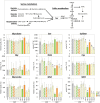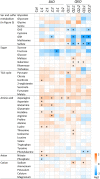The Effect of Single and Multiple SERAT Mutants on Serine and Sulfur Metabolism
- PMID: 29892307
- PMCID: PMC5985473
- DOI: 10.3389/fpls.2018.00702
The Effect of Single and Multiple SERAT Mutants on Serine and Sulfur Metabolism
Abstract
The gene family of serine acetyltransferases (SERATs) constitutes an interface between the plant pathways of serine and sulfur metabolism. SERATs provide the activated precursor, O-acetylserine for the fixation of reduced sulfur into cysteine by exchanging the serine hydroxyl moiety by a sulfhydryl moiety, and subsequently all organic compounds containing reduced sulfur moieties. We investigate here, how manipulation of the SERAT interface results in metabolic alterations upstream or downstream of this boundary and the extent to which the five SERAT isoforms exert an effect on the coupled system, respectively. Serine is synthesized through three distinct pathways while cysteine biosynthesis is distributed over the three compartments cytosol, mitochondria, and plastids. As the respective mutants are viable, all necessary metabolites can obviously cross various membrane systems to compensate what would otherwise constitute a lethal failure in cysteine biosynthesis. Furthermore, given that cysteine serves as precursor for multiple pathways, cysteine biosynthesis is highly regulated at both, the enzyme and the expression level. In this study, metabolite profiles of a mutant series of the SERAT gene family displayed that levels of the downstream metabolites in sulfur metabolism were affected in correlation with the reduction levels of SERAT activities and the growth phenotypes, while levels of the upstream metabolites in serine metabolism were unchanged in the serat mutants compared to wild-type plants. These results suggest that despite of the fact that the two metabolic pathways are directly connected, there seems to be no causal link in metabolic alterations. This might be caused by the difference of their pool sizes or the tight regulation by homeostatic mechanisms that control the metabolite concentration in plant cells. Additionally, growth conditions exerted an influence on metabolic compositions.
Keywords: O-acetylserine; cysteine; serine; serine acetyltransferase; subcellular compartment.
Figures





Similar articles
-
Impact of sulfur starvation on cysteine biosynthesis in T-DNA mutants deficient for compartment-specific serine-acetyltransferase.Amino Acids. 2010 Oct;39(4):1029-42. doi: 10.1007/s00726-010-0580-9. Epub 2010 Apr 9. Amino Acids. 2010. PMID: 20379751
-
Characterization of the serine acetyltransferase gene family of Vitis vinifera uncovers differences in regulation of OAS synthesis in woody plants.Front Plant Sci. 2015 Feb 17;6:74. doi: 10.3389/fpls.2015.00074. eCollection 2015. Front Plant Sci. 2015. PMID: 25741355 Free PMC article.
-
Comparative genomics and reverse genetics analysis reveal indispensable functions of the serine acetyltransferase gene family in Arabidopsis.Plant Cell. 2008 Sep;20(9):2484-96. doi: 10.1105/tpc.108.060335. Epub 2008 Sep 5. Plant Cell. 2008. PMID: 18776059 Free PMC article.
-
Manipulation of thiol contents in plants.Amino Acids. 2001;20(3):291-9. doi: 10.1007/s007260170045. Amino Acids. 2001. PMID: 11354605 Review.
-
Molecular and biochemical analysis of serine acetyltransferase and cysteine synthase towards sulfur metabolic engineering in plants.Amino Acids. 2002;22(3):231-43. doi: 10.1007/s007260200011. Amino Acids. 2002. PMID: 12083067 Review.
Cited by
-
Down-regulation of Fra a 1.02 in strawberry fruits causes transcriptomic and metabolic changes compatible with an altered defense response.Hortic Res. 2021 Mar 10;8(1):58. doi: 10.1038/s41438-021-00492-4. Hortic Res. 2021. PMID: 33750764 Free PMC article.
-
The Serine Acetyltransferase (SAT) Gene Family in Tea Plant (Camellia sinensis): Identification, Classification and Expression Analysis under Salt Stress.Int J Mol Sci. 2024 Sep 10;25(18):9794. doi: 10.3390/ijms25189794. Int J Mol Sci. 2024. PMID: 39337281 Free PMC article.
-
Genome-Wide Association Reveals Trait Loci for Seed Glucosinolate Accumulation in Indian Mustard (Brassica juncea L.).Plants (Basel). 2022 Jan 28;11(3):364. doi: 10.3390/plants11030364. Plants (Basel). 2022. PMID: 35161346 Free PMC article.
-
Distinct heat response molecular mechanisms emerge in cassava vasculature compared to leaf mesophyll tissue under high temperature stress.Front Plant Sci. 2023 Nov 30;14:1281436. doi: 10.3389/fpls.2023.1281436. eCollection 2023. Front Plant Sci. 2023. PMID: 38098787 Free PMC article.
-
Metabolite Changes in an Estuarine Annelid Following Sublethal Exposure to a Mixture of Zinc and Boscalid.Metabolites. 2019 Oct 15;9(10):229. doi: 10.3390/metabo9100229. Metabolites. 2019. PMID: 31618973 Free PMC article.
References
LinkOut - more resources
Full Text Sources
Other Literature Sources
Research Materials

